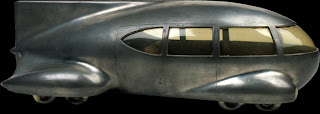
When my sister and I drove from Boston to Santa Fe last summer, we took turns reading aloud to each other from a book our father had given us for the occasion,
Cross Country by Robert Sullivan--a book I highly recommend. A section of the book which I have continued to think about has to do with the development of the interstate highway system.
Sullivan contrasts the work of two influential 20th century thinkers--Norman Bel Geddes and Benton MacKaye--and I'll try to summarize here briefly.

1934 patent model by Norman Bel Geddes, University of Texas collectionBel Geddes was an artist and an advertising man, and then a theatrical designer--designing stages and sets for Cecil B. DeMille, D.W. Griffith, and Flo Ziegfeld. He then turned his attention and considerable skills to industrial design, using a principle he called "streamlining" to design, among other things, planes, cars, warships, a mattress, a meat-slicing machine, a stapler, a rum factory, luggage, and the first gas station pump that automatically calculated the price of gas. According to Bel Geddes, streamlining involved reducing friction and increasing speed. In highways, this could be realized through straight lines, fewer intersections, and fast exit and entry ramps.
Bel Geddes designed a highway of the future called the Magic Motorway and showcased it at the 1939 World's Fair, in an exhibit entitled "Futurama" that was sponsored by General Motors. The following year, Franklin Roosevelt asked him to design a possible national motorway. You can read more about Bel Geddes
here. (For you trivia buffs, he was also the father of Barbara Bel Geddes, an actress who played Miss Ellie Ewing on the TV show
Dallas.)
 Photo courtesy of the Appalachian Trail Conservancy
Photo courtesy of the Appalachian Trail ConservancyBy contrast, Benton MacKaye was a wilderness man. (Coincidentally, he also came from a theatrical family--his father was an actor, writer, and director and the first American to play Hamlet in London.) He grew up in the country, and the first mountain he climbed changed his life. He joined the US Forest Service after graduating from Harvard, and later became a journalist, writing radical editorials and hanging out with Sinclair Lewis, Dean Acheson, and Louis Brandeis. He also cofounded the Regional Planning Association of America and the Wilderness Society.
MacKaye saw transportation planning as a way of orchestrating the movement of people and things. He wanted to consider roads in combination with train, boat, and plane traffic, and looked to control cars, rather than have cars control us. He saw the development of highways as a way to influence urban growth. He believed that access to the wilderness was important for everyone. His greatest accomplishment was probably the design of the Appalachian Trail--which he saw as a "West for the East"--a way for Easterners to get a western national park experience--accessible to everyone, not just the wealthy. (FYI, the Appalachian Trail is now 2,167 miles long, crosses 14 states, and is hiked by 14 million people a year.)
Even in retirement, he continued to work on trail design--giving Interior Secretary Stewart Udall two new designs in 1966 (when MacKaye was 87 years old) for the Continental Divide Trail and the Pacific Crest Trail, which now both exist. You can read more about MacKaye
here and
here. Bel Geddes focused on streamlining the road itself--he saw cars eventually able to travel the interstates at 300 mph. MacKaye was more interested in people. In Bel Geddes' view, you steamrolled over obstacles to build the highway where you wanted it to go--straight and flat. In MacKaye's view, you took the people and their purposes and the countryside into consideration. It's clear which design possiblity for American highways won out, isn't it?
The development of a Bel Geddes-style national highway system was furthered by Dwight Eisenhower, who was heavily influenced by his military background. Part of the reason for looping highways around cities was so that cities destroyed by atomic bombs could be skirted! Also, interstates would give the government a way to evacuate populations in case of a Soviet attack. And broad straight multi-lane highways could be used as airplane runways in emergency situations.
And so we developed a highway program rather than a transportation program--road builders building for the sake of road building--and seriously neglected mass transit. Even when highways were built through cities they were typically built through black neighborhoods where little political resistance was mounted (and were designed to move people quickly from their city jobs to the white suburbs).
If you think about the area where you live, you can probably see the results of these efforts. I'd love to see you reply to this post with some examples.
 Photo courtesy of www.indianz.com
Photo courtesy of www.indianz.com














